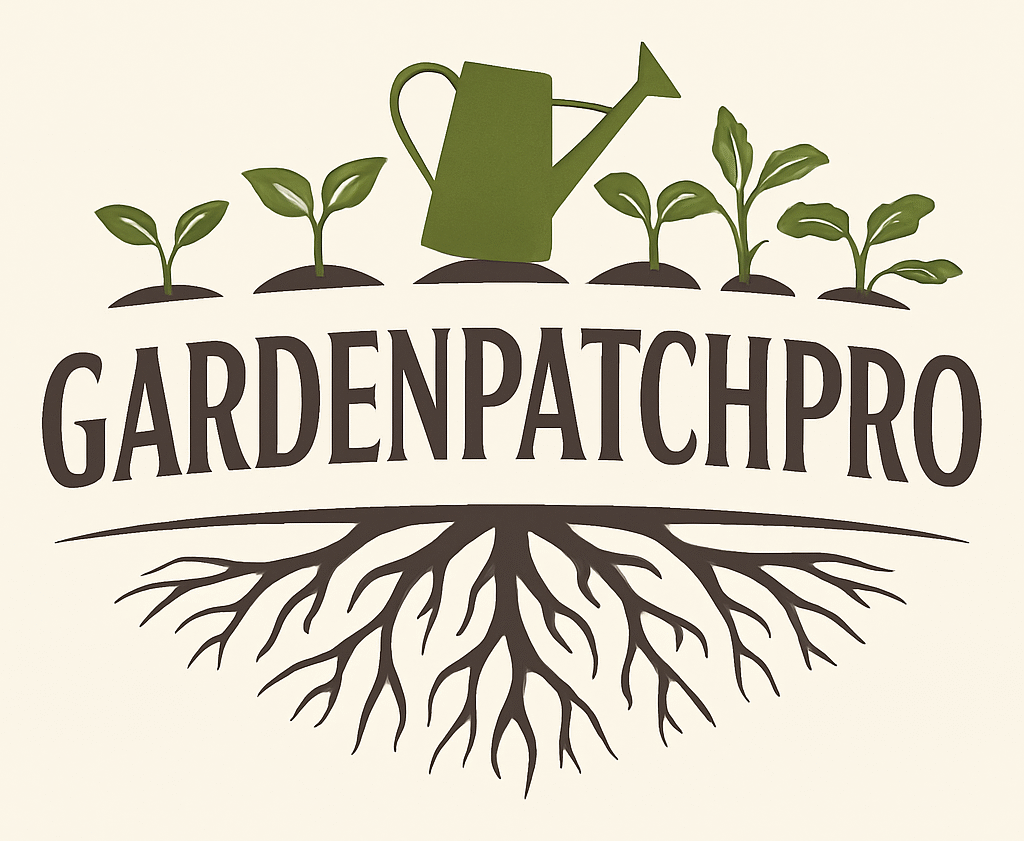12 Terrarium Ideas for Stunning Indoor Greenery and Easy Care
Terrariums offer a simple way to bring a touch of nature indoors, making them popular for people with limited outdoor space. They combine plants, containers, and design to create small, decorative gardens that fit easily in homes or offices.
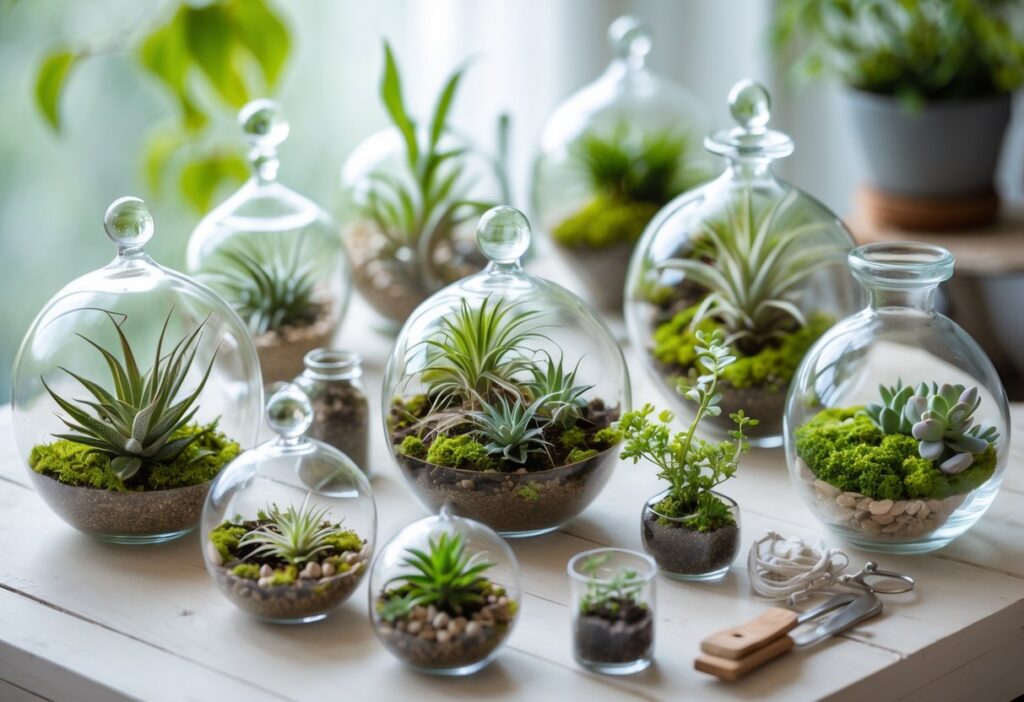
They provide an easy, low-maintenance way to add greenery and style to any space. Terrariums can vary in size and style, giving plenty of options for creativity and personalization.
1) Succulent Desert Terrarium with sand and stones
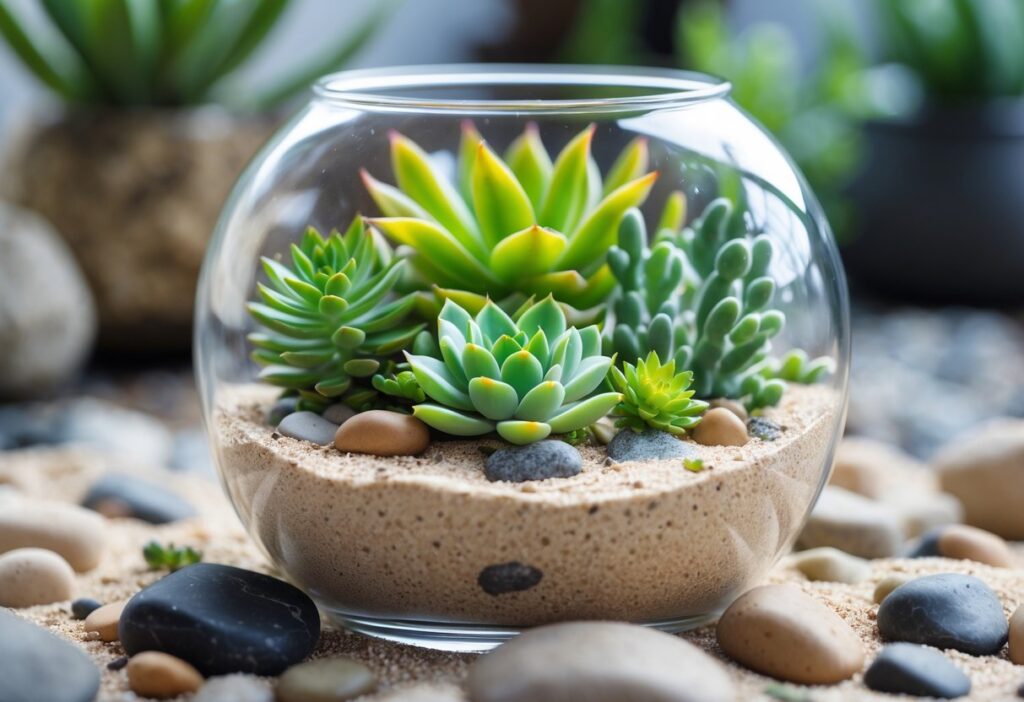
A succulent desert terrarium uses sand and stones to create a dry, natural look. It mimics the environment of a desert, which suits cacti and other succulents.
The terrarium needs an open container for airflow to prevent moisture build-up that can harm the plants. Drainage is important, so adding small stones at the bottom helps water move away from roots.
Sand acts as a top layer, giving the terrarium a clean and minimalist feel. Stones add texture and can be arranged to create paths or small designs. This layering also helps keep the soil dry and aerated.
Choosing the right succulents matters. Plants like Echeveria, Sedum, and Haworthia work well because they store water and thrive in dry soil. They need minimal watering and plenty of light.
This type of terrarium is low-maintenance, making it perfect for people who want a desert-style plant display without hassle. Instructions for making one can be found in the step-by-step desert terrarium guide.
2) Tropical Rainforest Terrarium with ferns and moss

A tropical rainforest terrarium often features a mix of ferns and moss to create a lush, green environment. These plants thrive in high humidity, which mimics their natural habitat. The moss provides a soft, carpet-like ground cover, while ferns add height and texture.
To build this terrarium, start with a layer of gravel for drainage. Add activated charcoal next to prevent odors and keep the terrarium fresh. Finally, use a rich potting soil to support plant growth.
Choosing small ferns and various moss types helps achieve a natural jungle feel. Adding mini orchids or bromeliads can offer extra color and interest. A tall glass container can support layering and gives the plants enough room to grow.
Maintaining humidity is important. Mist the terrarium regularly or use a closed container to keep moisture in. Avoid direct sunlight to prevent overheating, which can harm delicate plants. This setup creates a peaceful, green space that brings part of the rainforest indoors. For more ideas, see tropical rainforest terrarium tips with ferns and moss.
3) Air Plant Hanging Terrarium in Glass Globes
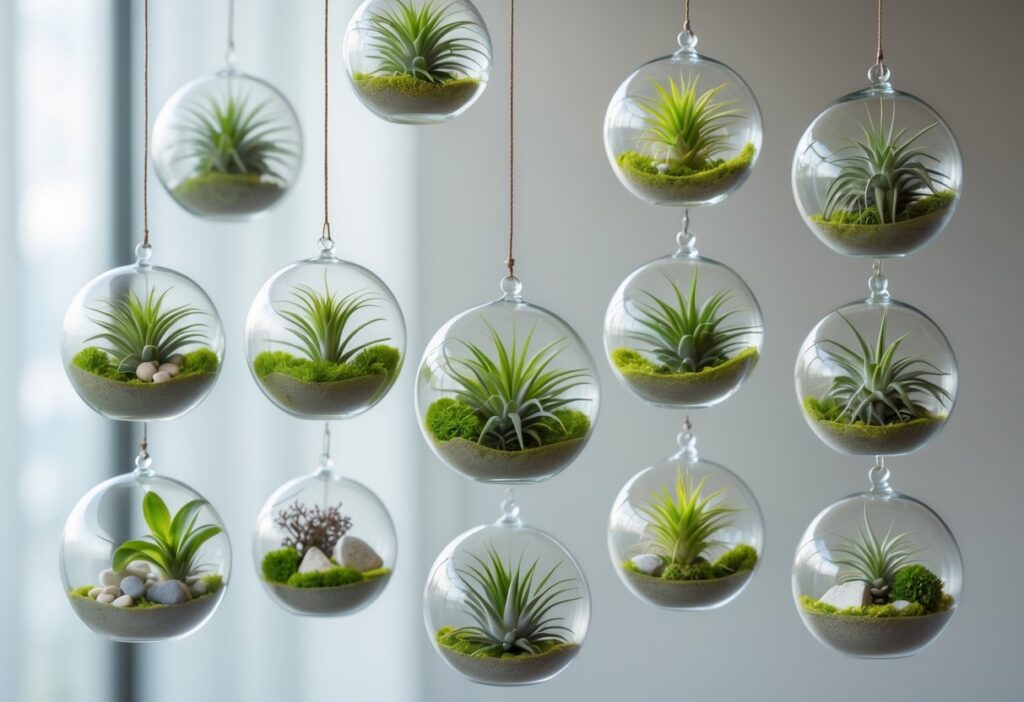
Air plants thrive without soil, making them perfect for hanging terrariums in glass globes. These globes offer a clean and modern way to display plants while letting light reach them from all sides.
The glass globe can be hung by a string, wire, or natural branch. This lets the terrarium float in the air, saving space and adding visual interest to any room.
Inside the globe, air plants can be paired with small stones, shells, or moss for added texture. The setup needs regular misting or soaking to keep the plants healthy.
Glass globes come in many shapes like spheres or teardrops. Their transparent design allows the air plants’ unique shapes and colors to be the focal point.
This style is easy to customize and fits well in offices, kitchens, or living rooms. For examples and ideas on hanging glass globe terrariums, see air plant natural hanging displays.
4) Miniature Jungle Terrarium with small palms

This terrarium style features small palm plants that add a tropical feel to a compact space. Small palms like parlor palms or ponytail palms work well because they stay petite and adapt to low light.
The setup usually includes layers of soil, charcoal, and pebbles for drainage. The palms prefer humid conditions, which a closed glass container can provide.
Adding moss or tiny ferns around the palms enhances the jungle look. The humidity inside the jar helps keep the plants healthy without daily watering.
This type of terrarium is great for those who want a lush, green display that remains manageable in size. It fits well on desks or shelves.
For detailed care tips and design ideas, see this guide on creating a mini jungle terrarium.
5) Closed Jar Moss Terrarium for humidity lovers
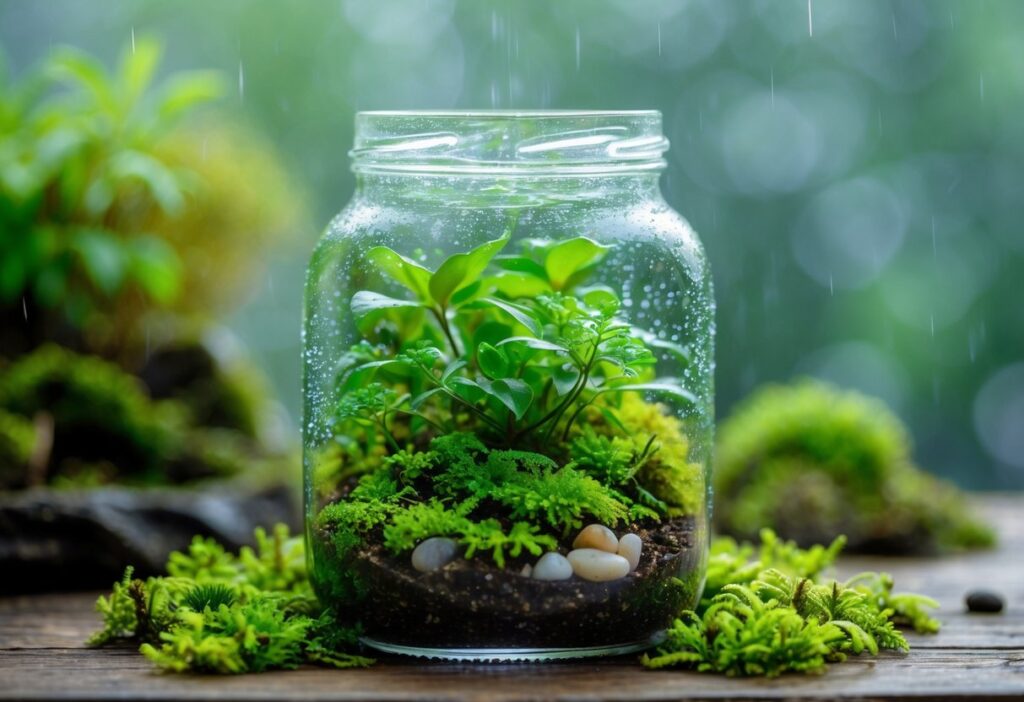
A closed jar moss terrarium is perfect for those who want to keep humidity levels high. The sealed glass container traps moisture inside, creating a damp environment ideal for moss growth. This setup mimics a natural rainforest, making it easier to care for humidity-loving plants.
Moss varieties like Java Moss, Christmas Moss, and Flame Moss do well in these terrariums. They can survive both underwater and in the humid air inside the jar. The moss absorbs moisture from the air, staying healthy without frequent watering.
Using a clear glass jar with a lid helps keep the environment stable. It also allows light to enter, which moss needs to thrive. Adding small stones or gravel at the bottom helps with drainage and prevents water from sitting too long.
This type of terrarium is low-maintenance. It needs only indirect light and occasional misting if moisture drops. A closed jar moss terrarium is a simple way to enjoy a green, lively space with minimal care. More details on care and ideas can be found in this guide on the best moss for closed terrariums.
6) Succulent and Cactus Mixed Open Terrarium

A succulent and cactus mixed open terrarium is a popular design that blends the textures and shapes of both plant types. This style allows for a visually interesting display while keeping plant care simple.
Open terrariums provide good airflow, which succulents and cacti prefer. They avoid the moisture buildup found in closed terrariums that can cause root rot.
Care should be taken to choose plants with similar light and water needs. Many gardeners mix small pincushion cacti with various succulents to create balanced, thriving arrangements.
Adding layers of pebbles, charcoal, and well-draining soil helps maintain healthy roots. Decorative stones or colored sand can enhance the look without harming the plants.
The open design also makes it easy to water and check on plants. It is a good choice for beginners or anyone who wants a low-maintenance, attractive indoor garden.
More ideas for creating and caring for this type of terrarium are available in guides on open terrariums and succulent combinations.
7) Layered Soil and Pebbles Terrarium Base

A terrarium with layered soil and pebbles starts with a solid base for proper drainage. Pebbles or small rocks are placed at the bottom to allow excess water to drain away from plant roots. This helps prevent waterlogging, which can damage plants.
Next, a thin layer of activated charcoal is added. This keeps the terrarium fresh by absorbing odors and harmful bacteria. On top of that, a layer of soil is added, chosen to match the types of plants in the terrarium.
The soil layer supports plant growth by holding nutrients and moisture. Some people like to add moss or decorative stones on top for extra color and texture. This setup creates a healthy environment inside the terrarium, balancing moisture and air flow.
Proper layering is key to making a terrarium last. Without good drainage and the right soil, plants can suffer from too much water or poor roots health. This method is simple but effective for both beginners and experienced gardeners.
More tips on layering terrariums can be found in this detailed guide on terrarium layering techniques.
8) Fairy Garden Terrarium with miniature figurines
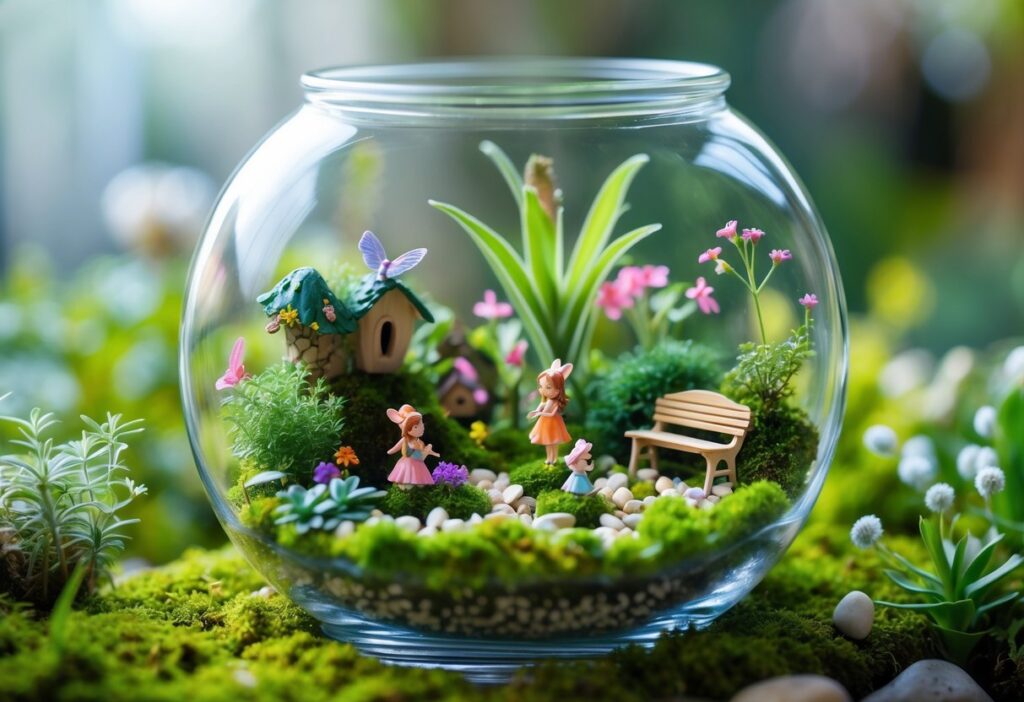
A fairy garden terrarium uses small plants, moss, and tiny figurines to create a miniature magical world. The figurines often include fairies, woodland animals, or tiny houses. These elements bring a whimsical feel and add character to the terrarium.
Miniature fairy figurines are usually hand-painted and carefully detailed. They fit well in small glass containers, helping to build a storybook-like scene. Adding decorative moss and pebbles enhances the natural look.
The layout can be simple or more complex with pathways, furniture, and multiple figures. Tiny mushroom figurines or fairy garden accessories give extra charm and detail. This style blends nature with fantasy, making it a popular choice for indoor plant displays.
To start, it is important to choose waterproof figurines to avoid damage. The size of the container affects how many pieces can be included. Larger terrariums may hold several figurines and additional decorations, creating a more intricate design.
For inspiration on creating these magical miniature landscapes, visit fairy garden terrarium ideas to spark creativity and discover tips.
9) Woodland Theme Terrarium with pinecones and bark
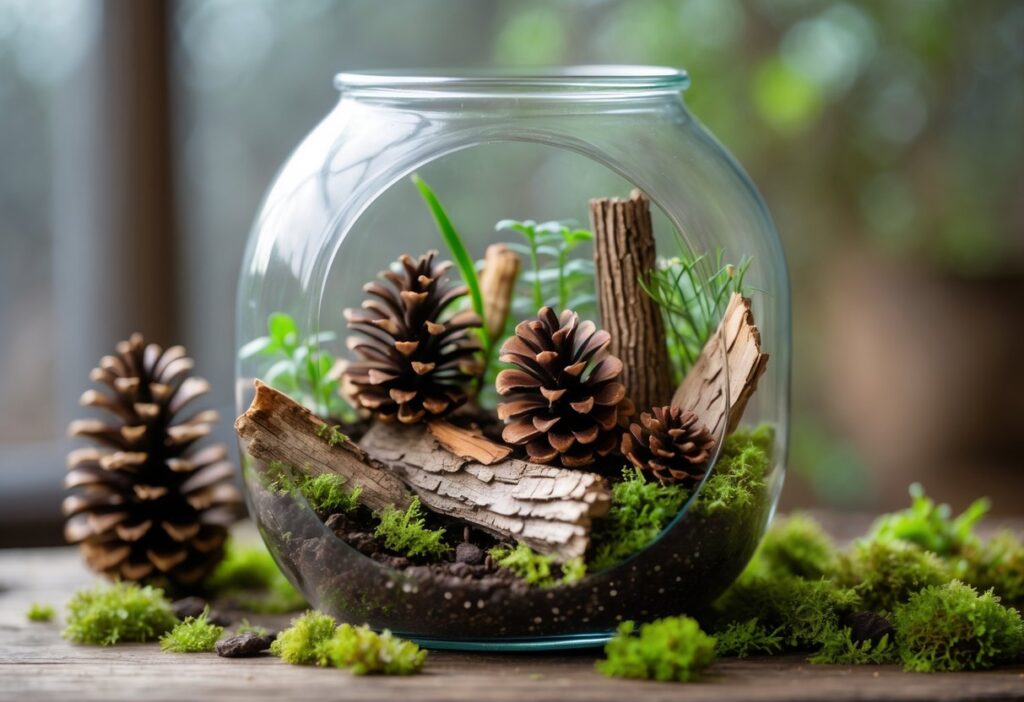
A woodland theme terrarium often features natural elements like pinecones and bark to create a forest floor look. These pieces add texture and make the small space feel more like a real woodland.
They can be paired with ferns, moss, and small plants to mimic a natural forest setting. Using a closed glass container helps keep the humidity high, which supports moisture-loving plants.
Adding tiny twigs, small rocks, and miniature woodland creatures like deer or owls can enhance the theme. These details make the terrarium more interesting and realistic.
Pinecones and bark are easy to find and help bring authenticity to the design. They also provide contrast to the green plants inside. This style works well for anyone wanting a peaceful, natural vibe in their home or office space.
For more ideas on how to decorate a woodland terrarium, see creative tips involving pinecones and natural materials at terrariumtribe.com.
10) Geometric Glass Container Terrarium
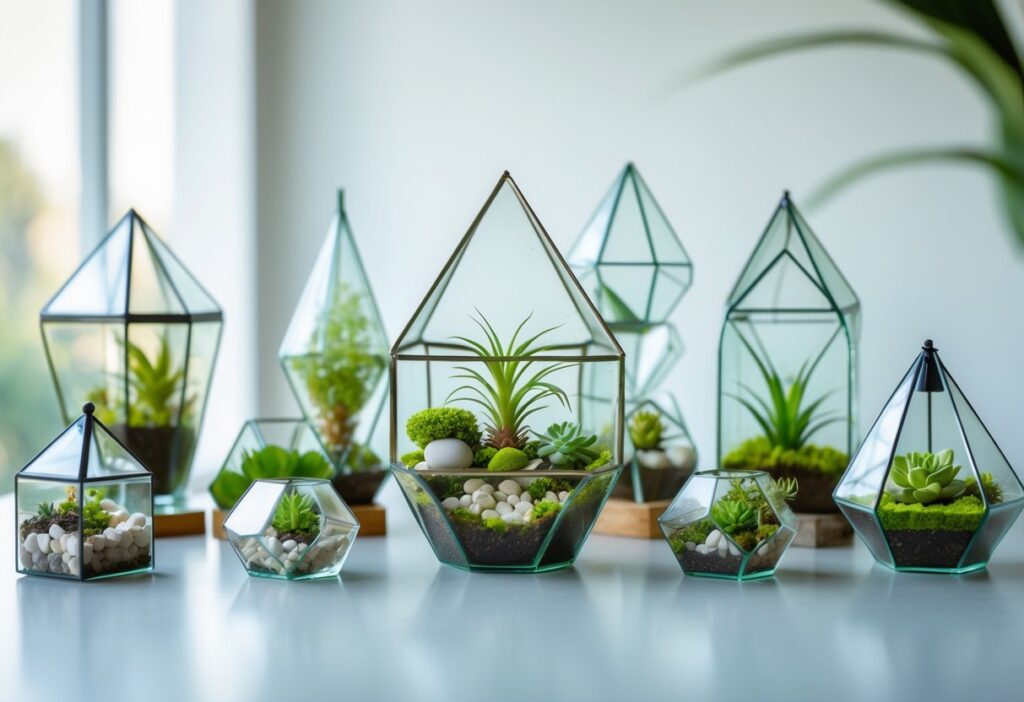
Geometric glass container terrariums are popular for their clean lines and modern style. They come in shapes like pyramids, cubes, and hexagons. These shapes create a unique display that highlights the plants inside.
These terrariums work well with succulents and small cacti. The clear glass lets in plenty of light, which is important for the plants’ growth. The angular sides also add depth and interest to the arrangement.
People often choose geometric containers because they fit nicely on desks, shelves, or tables. Their size makes them easy to care for while adding a small touch of nature indoors. A variety of plants and stones can be arranged inside to create a personalized look.
For those wanting ideas or to buy, many designs are available online and can be found in collections of unique geometric glass terrarium ideas. These containers make it simple to add style and greenery to any room.
11) Mini Desert Oasis with colorful sands and succulents
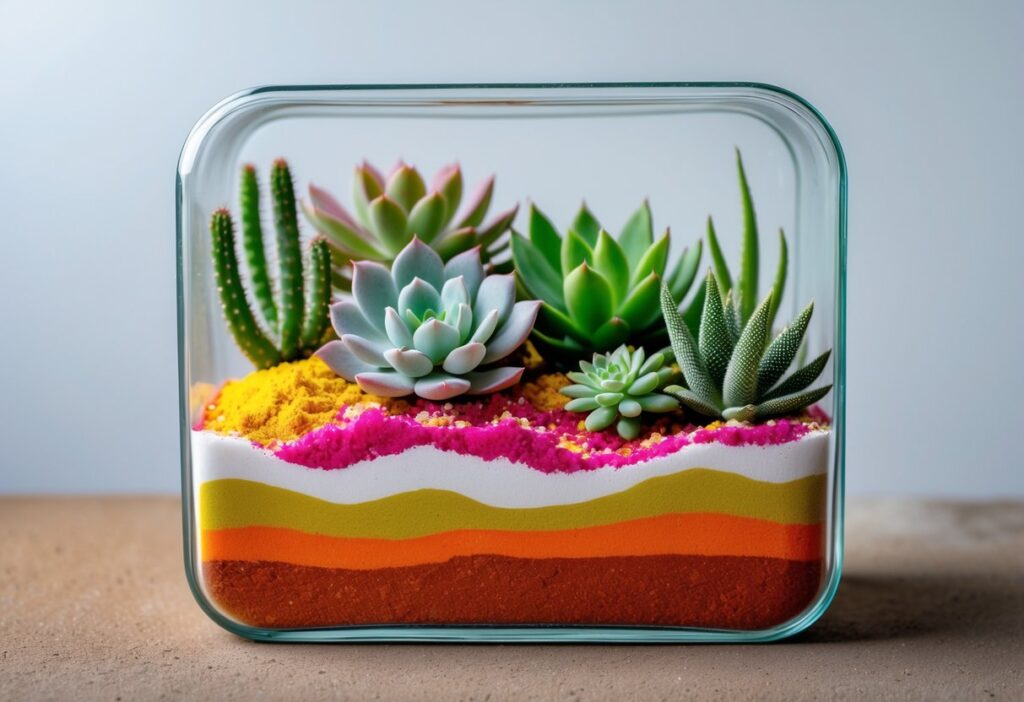
A mini desert oasis terrarium combines colorful sands with small succulents to create a striking indoor display. The layers of different sand colors add visual interest and mimic the natural desert landscape.
Succulents like Echeveria or Haworthia work well because they need little water and thrive in dry conditions. Their varied shapes and colors contrast nicely with the sand, making the terrarium lively yet simple.
Using bright sands helps highlight the plants and adds texture. This setup is low-maintenance, requiring only occasional watering and good light.
The open container style encourages airflow, preventing moisture buildup, which suits desert plants well. This makes it a practical choice for beginners and those who want a neat, natural look indoors.
More tips on making a desert terrarium can be found in this guide to creating a desert terrarium with succulents and sandscapes.
12) Closed Tropical Fern and Orchid Terrarium
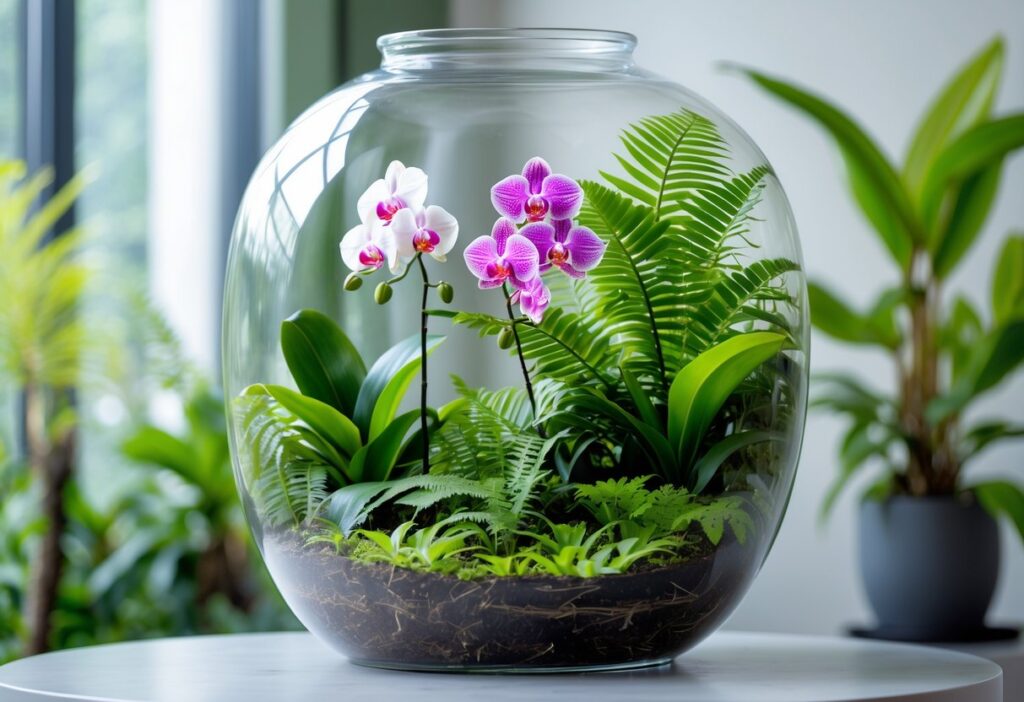
This terrarium combines ferns and orchids in a sealed glass container. The closed design helps keep humidity high, which both plants need. Ferns and orchids thrive in moist, warm environments, making this setup ideal.
The sealed container creates a natural water cycle through evaporation and condensation. This means less frequent watering is required. It also helps maintain a stable temperature and humidity level.
Small ferns like maidenhair or button fern work well with orchids inside. They fit in compact spaces and enjoy low light. Orchids add a splash of color and texture among the green ferns.
This type of terrarium should be placed where indirect light is available. Direct sunlight can overheat the container and harm the plants. Proper ventilation is important too, so it’s good to open the terrarium occasionally to let fresh air in.
Closed tropical terrariums offer a simple way to grow humidity-loving plants together. They create a miniature jungle that needs little care but shows healthy, lush growth. More ideas on combining ferns and orchids can be found in orchid terrarium guides like this one from Balcony Garden Web.
Essential Terrarium Care Tips

Proper care is key to keeping a terrarium healthy and attractive. It involves selecting plants suited for small, enclosed spaces, managing light carefully to avoid burning or stunting growth, and balancing watering to maintain enough moisture without causing mold or root rot.
Choosing the Right Plants
Selecting plants that fit the terrarium environment is critical. Most terrarium plants thrive in humid, low-ventilation spaces. Common choices include ferns, mosses, and small tropical plants because they tolerate moisture well and grow slowly.
Succulents and cacti suit open terrariums with good airflow but do not do well in enclosed, high-humidity cases. Mixing plant types with similar light and moisture needs helps avoid care conflicts.
The plants should be small or slow-growing to prevent overcrowding. Overcrowding causes poor air circulation and increases the risk of diseases. It is best to avoid large or fast-growing species that will quickly outgrow the space.
Optimal Lighting and Placement
Terrarium plants need bright but indirect sunlight. Direct sunlight can cause overheating and burn leaves. Windows with filtered light or spots near but not directly in the sun are ideal.
Artificial grow lights work well, especially for terrariums placed in darker rooms. LED lights with a timer help provide consistent light without excess heat.
Placement should avoid drafts or heaters, which dry out the terrarium. Maintaining a stable temperature between 60°F and 75°F supports healthy growth. Too little light will slow photosynthesis and cause weak plants.
Watering and Humidity Management
Watering terrariums requires balance. Closed terrariums recycle moisture but can build too much humidity if overwatered. Open terrariums dry out faster and need more frequent watering.
A misting spray bottle is useful for applying water evenly and avoiding water pooling. Signs of overwatering include mold growth and cloudy condensation inside the glass.
Proper soil drainage is necessary to prevent root rot. A layer of small rocks or charcoal at the bottom of the container helps water drain away from roots.
Maintaining moderate humidity prevents drying or mold. This often means watering once every 1-2 weeks, depending on plant type and container airflow.
Decorative Elements and Customization
A terrarium’s look depends a lot on the materials chosen and the theme set by the creator. Using natural items adds texture and realism. Choosing a clear idea or theme helps bring personality and style to the miniature garden.
Incorporating Natural Materials
Natural materials like pebbles, wood, and moss add structure and visual interest. Pebbles form a clean base layer that improves drainage and keeps the soil healthy. Driftwood or small branches introduce shapes and height, creating depth in the terrarium.
Moss adds soft texture and a fresh green color, making the space feel lush. It also helps retain moisture for the plants. Combining these elements provides a balanced mix of hard and soft surfaces.
Adding natural materials follows practical purposes and enhances the overall design. Using materials native to the plants’ environment can also help the terrarium thrive. For more ideas on decorative pebbles and moss, see Creative Terrarium Ideas.
Creative Theming Ideas
Choosing a specific theme gives the terrarium a distinct look. Some popular themes include woodland fairy habitats, desert oases, and geometric modern designs.
A woodland fairy theme might include miniature figurines, small pine cones, and moss, creating a magical forest feel. The desert theme uses succulents, sand, and rocks to mimic dry terrain with striking contrasts.
Geometric terrariums use modern containers with sharp angles. They focus on clean lines and simple plant arrangements for a minimalist look.
Theming helps decide what decorations to add while making the terrarium a personal statement. More theme choices and style tips are available at 27+ Creative Terrarium Ideas.
Frequently Asked Questions
Creating a terrarium involves choosing the right materials, plants, and design themes. It also includes understanding how to maintain the mini ecosystem and how to customize it for personal taste.
What are the essential components needed for a DIY terrarium?
A DIY terrarium needs a clear container, such as a glass jar or fish tank. It also requires drainage material like small stones or pebbles, activated charcoal to prevent odor, potting soil suited for the plants, and selected plants.
How do you select plants that thrive in a closed terrarium environment?
Plants that do well in closed terrariums include ferns, moss, and small succulents. These plants prefer humid conditions and low light, fitting the moisture and light levels inside sealed glass containers.
What are innovative themes for creating a school project terrarium?
Creative themes include a Succulent Desert Terrarium with sand and stones or a Tropical Rainforest Terrarium with ferns and moss. Other ideas are an Air Plant Hanging Terrarium in glass globes or a Miniature Jungle Terrarium featuring small palms.
Can a terrarium be sustainable without live plants, and if so, what are the alternatives?
Yes, terrariums can use non-living materials like decorative stones, shells, artificial plants, or sand. These options create a low-maintenance display but do not offer the ecosystem benefits of live plants.
What is the step-by-step process for assembling an indoor terrarium?
Start with a clean glass container. Add a layer of drainage material, followed by charcoal. Then place the potting soil and arrange the plants carefully. Finish by watering lightly and sealing if creating a closed terrarium.
How can you personalize a glass terrarium to reflect individual style or decor?
Personalization can be done by choosing container shapes, adding decorative stones, figurines, or themed ornaments. Using colored sand, unique plant combinations, or custom lighting also helps match the terrarium to a specific style or room decor.
For more detailed ideas on terrarium care and design, see creative terrarium FAQs.
